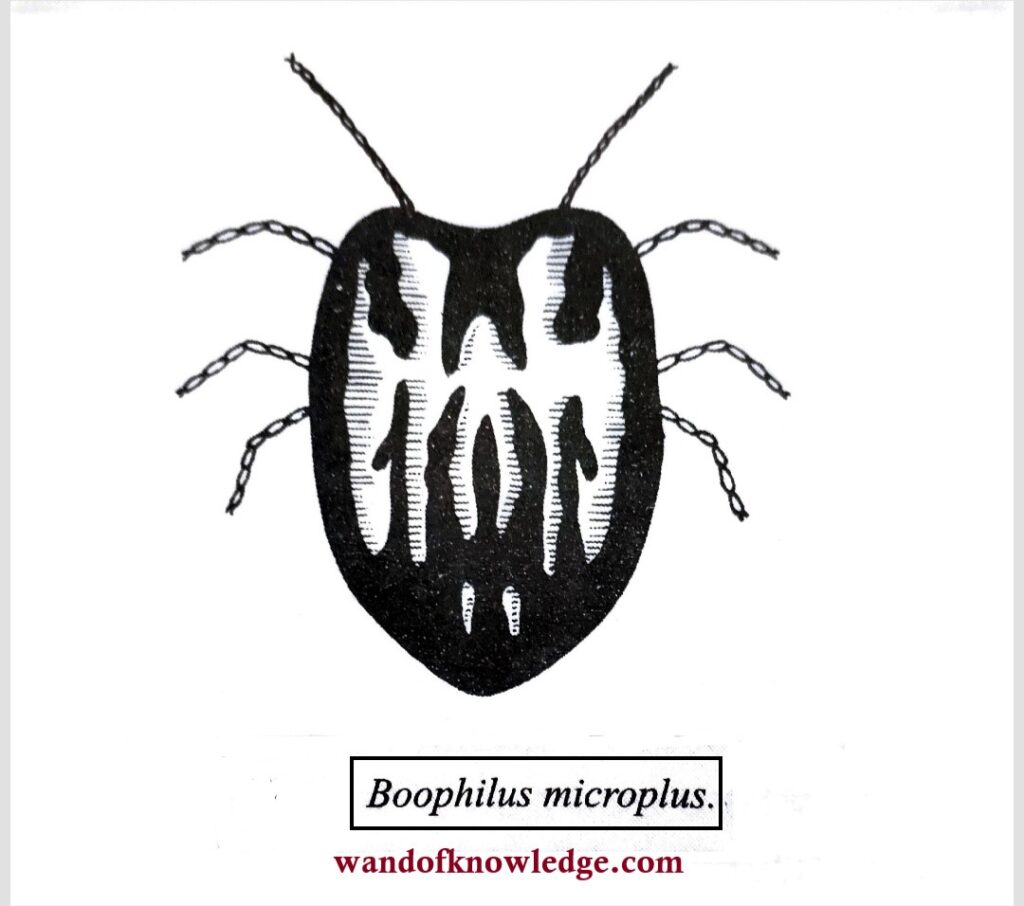Cattle Tick : Boophilus microplus (Canestrini) | Wandofknowledge
Classification
- Phylum- Arthropoda
- Class- Arachnida
- Order- Acarina
- Family- Ixodidae
- Genus- Boophilus

The cattle tick mainly attacks the cattle but is also found on horses, mules, deer, goats and sheep. All the stages viz., larva, nymph and adult suck the blood from the host. They spread cattle fever, tick fever, texas fever from sick individuals to healthy ones. The symptoms of tick fever are high fever, reddish discoloration of urine, enlargement of spleen, loss of flesh, arched back and dropping ears. The protozoan, Boophilus annulatus is responsible for this disease which destroys the red corpuscles of the blood. Thus, this disease is caused by a protozoan parasite but only the ticks are responsible for the spread of this disease. The germs of texas fever are carried through the eggs of diseased ticks which infect the new individual.
Morphology :
After maturity the female cattle tick attains a length of about 0.1 mm. It is olive-green to bluish grey in colour. They are bean-shaped with hard and wrinkled skin. The Tarvae are smaller provided with 3 pairs of legs, whereas, nymphs and adults have 4 pairs of legs.
Life Cycle :
The female after mating lays eggs in the soil, cracks and crevices of buildings. A single female lays about 2000 eggs in clusters. The eggs hatch into six legged larva after 2 to 6 weeks. The larva attaches itself on a host. These larvae start feeding; get changed into young nymphs which attain adult stage feeding on the same infested cattle. Now mating takes place on the host’s body and adults drop to the soil surface to lay eggs for another generation. Four stages viz. eggs, seed tick, nymph and adult are found in this parasite. The adults exist in two phases i.e., parasitic and non-parasitic phase. Part of the life time of an adult female, egg stage and most of the seed tick (larva) stage comes under non-parasitic phase whereas a portion of the seed tick stage, complete nymphal stage and a part of adult female life is parasitic phase. Single life cycle needs about 60 days and 4 generations have been recorded in one year.
Damage :
The soft parts of host cattle is attacked by cattle tick. Mostly they attack the skin of ear and under and base of the tail. The ticks insert their heads into the skin and suck the blood due to which a number of diseases are transmitted.
Prevention and control :
- Ticks should be removed by hand picking and killed immediately.
- The animals affected by ticks should be sprayed by lindane dust or carbaryl/malathion 1%.
- Rotating pasture lands should be planned due to which all seed ticks will starve and die.
- Dairy cattle should be dipped in 0.175 to 0.19% arsenic trioxide.
- The quarantine activities should be maintained by the Government.
Important links
- Entamoeba histolytica : Lifecycle | Disease & Prevention
- Plasmodium: Lifecycle | Disease | Symptoms | Prevention | Treatment
- Leishmania donovani : Life cycle | Prevention and Control
- Trypanosoma gambiense: Life Cycle | Prevention and Control
- Leishmania tropica : Life Cycle | Prevention and Control
- Ascaris lumbricoides : Life Cycle | Disease | Pathogenesis | Prevention
- Wuchereria bancrofti : Life Cycle | Disease | Prevention
Disclaimer: wandofknowledge.com is created only for the purpose of education and educational sector. wandofknowledge.com does not own this book/ materials, neither created nor scanned. We provide the links which are already available on the internet. For any queries, disclaimer is requested to kindly contact us. We assure you we will do our best. We do not support piracy. If in any way it violates the law or there is any problem, please mail us on wandofknowledge539@gmail.com
